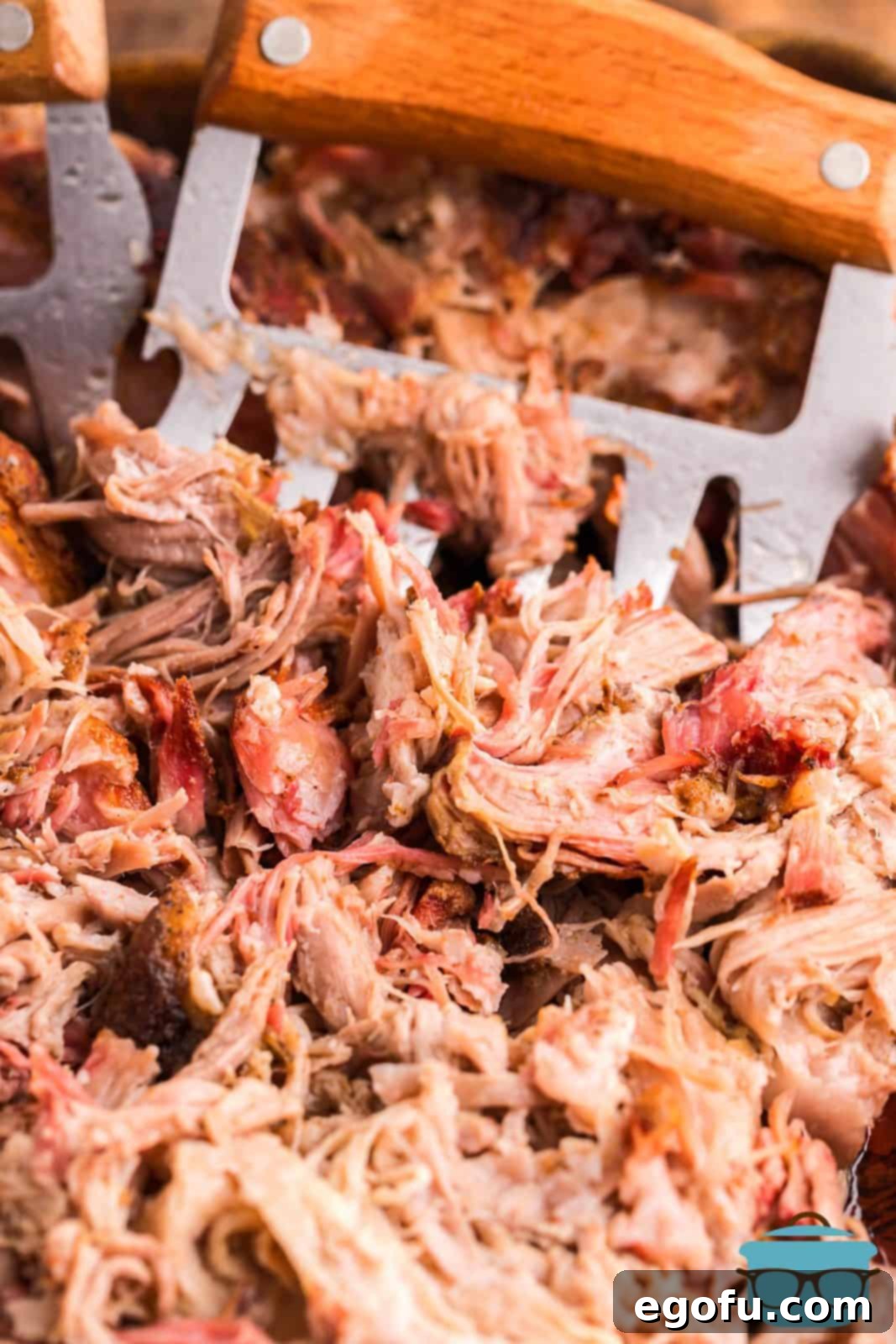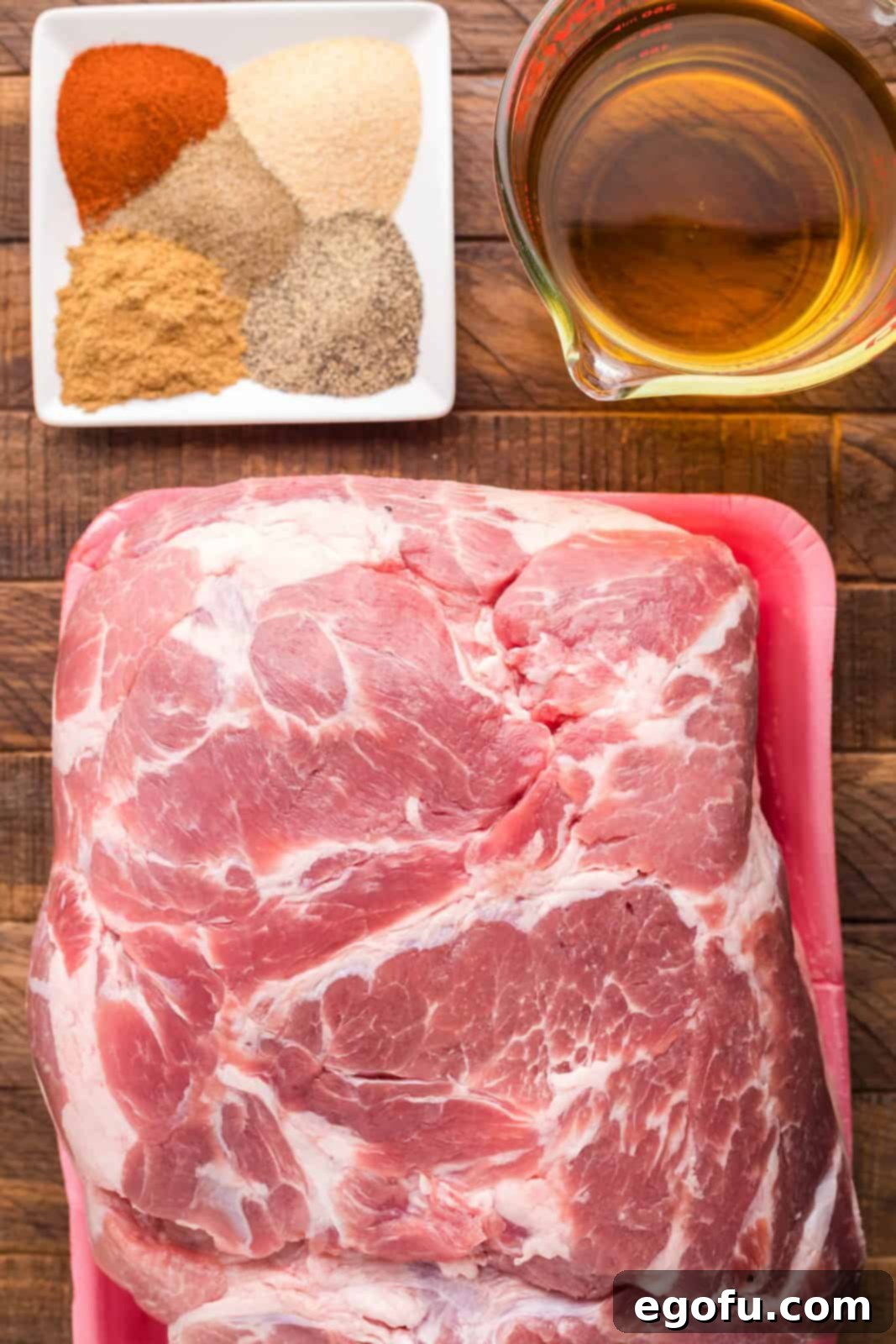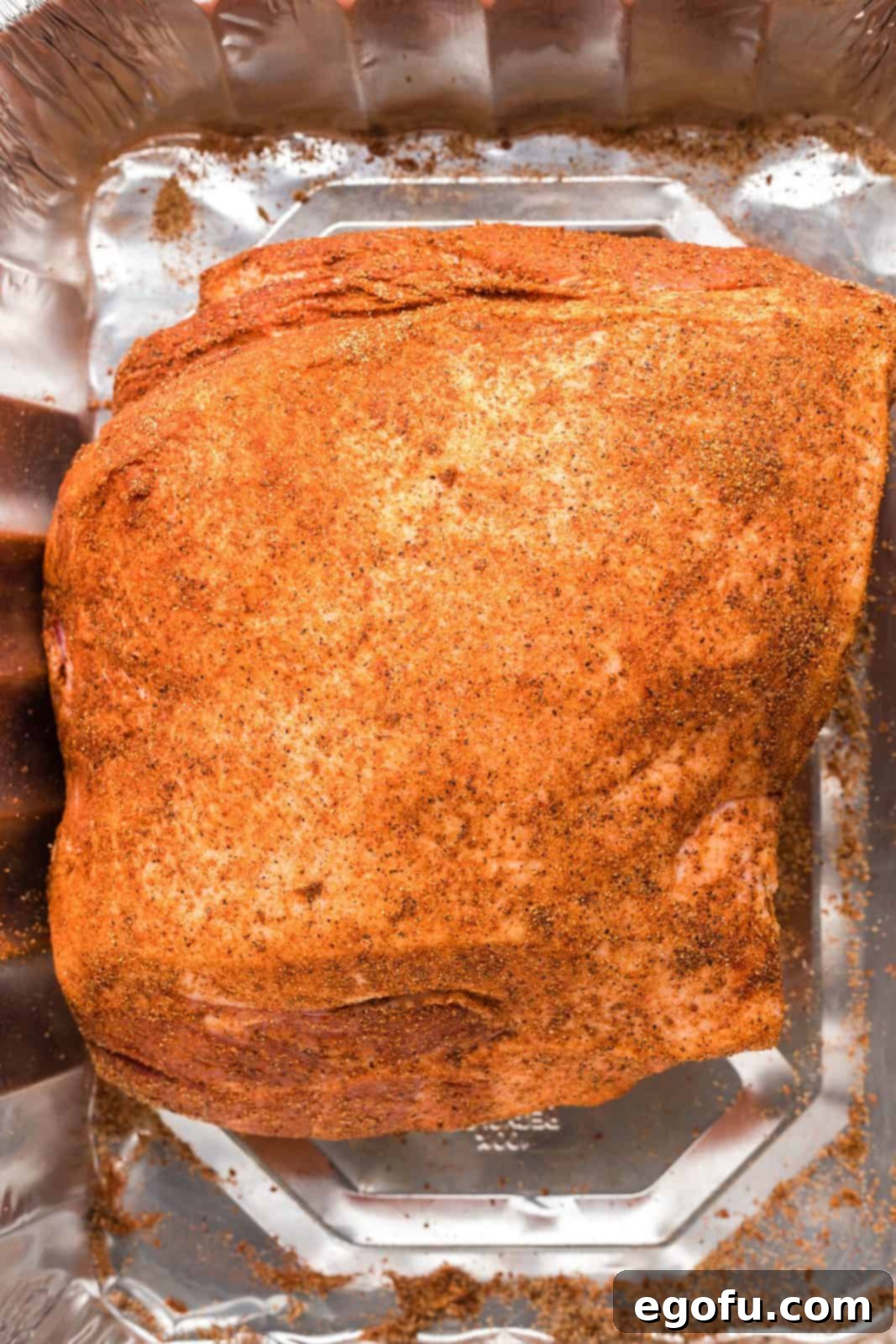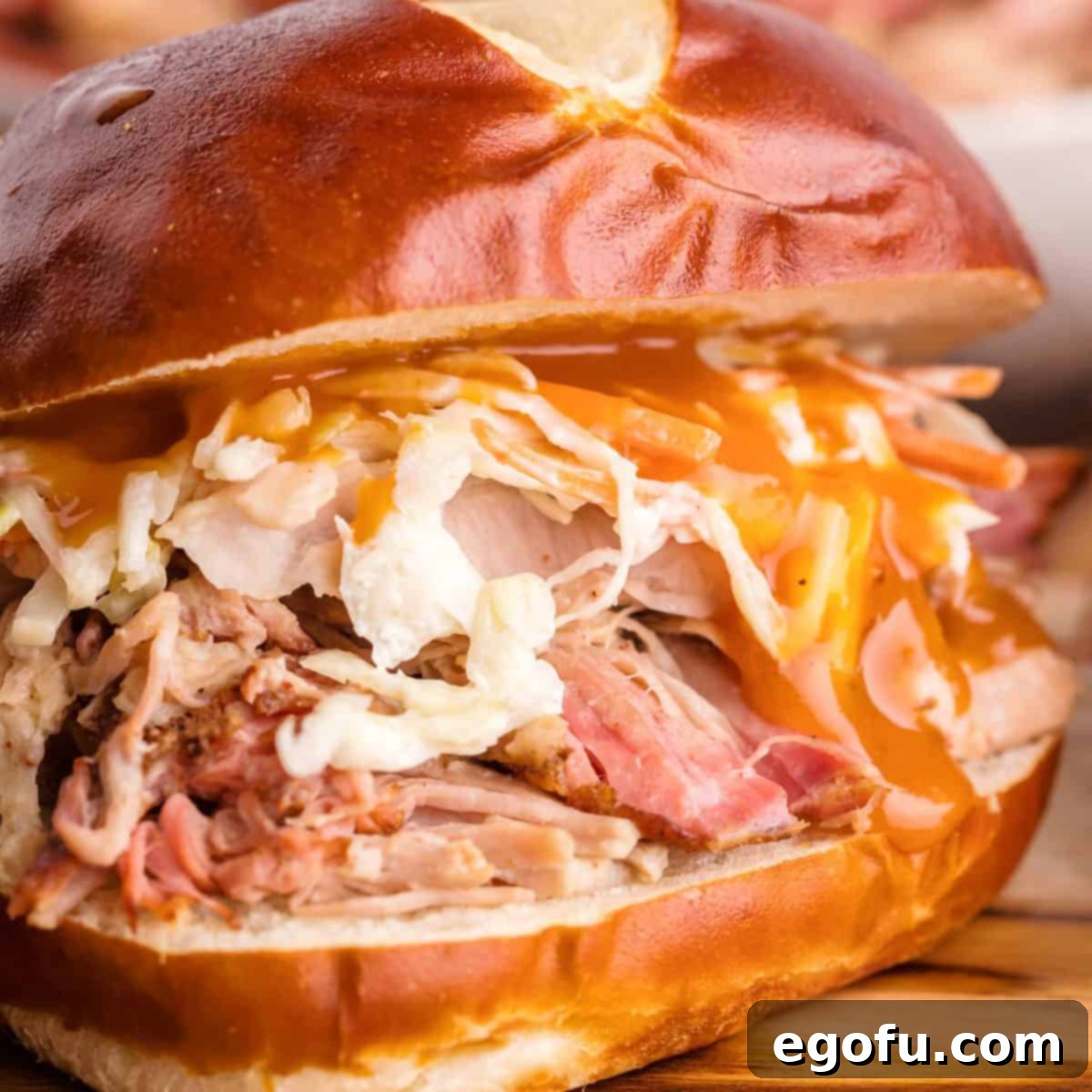Master the art of perfectly smoked pulled pork with this comprehensive guide. Tender, juicy, and packed with incredible flavor, this recipe will make you a barbecue legend!
Ultimate Smoked Pulled Pork Recipe: A Journey to Barbecue Bliss
There’s nothing quite like the aroma of a smoker working its magic, slowly transforming a humble cut of pork into something truly extraordinary. For barbecue enthusiasts and home cooks alike, Smoked Pulled Pork stands as a pinnacle of culinary achievement – a dish that embodies patience, passion, and unparalleled flavor. This guide, honed through countless smoking sessions on my trusty Traeger pellet smoker, will walk you through every step to create the most tender, juicy, and utterly mouthwatering pulled pork you’ve ever tasted.

Why Smoked Pulled Pork Reigns Supreme
Smoked pulled pork isn’t just a meal; it’s an experience. The deep, smoky flavor infused into every strand of pork is simply unbeatable, a testament to the “low and slow” cooking method. Unlike other quick-cook barbecue options, pulled pork demands time, but the reward is immense. The process breaks down tough connective tissues, rendering the meat incredibly tender and succulent. Whether served on a bun, as part of a platter, or in creative dishes, its versatility and deliciousness make it a crowd-pleaser every single time. My personal journey into smoking began with recipes like this, and it quickly became a new favorite for its rich, intense flavors that only a smoker can deliver.
The Magic of the Smoker
Modern wood pellet smokers have revolutionized the home barbecue scene, making the art of smoking more accessible than ever before. With precise temperature control and an easy way to introduce natural wood smoke, devices like the Traeger take much of the guesswork out of the equation. This allows you to focus on the essential techniques – the rub, the temperatures, and the timing – to achieve consistently fantastic results. While the process may be lengthy, requiring anywhere from 10 to 15 hours, the hands-on time is minimal, and the outcome is always well worth the wait.
The Art of Low and Slow: Unlocking Tenderness
The secret to truly exceptional pulled pork lies in patience. Cooking low and slow isn’t just a catchy phrase; it’s a fundamental principle rooted in the science of cooking. This method ensures maximum tenderness and moisture retention, allowing the pork to transform into its desired melt-in-your-mouth texture.
Understanding Pork Shoulder: Boston Butt vs. Picnic
For pulled pork, the cut of choice is almost always the pork shoulder, often referred to as a “Boston Butt” or “Pork Butt.” Despite its name, the Boston Butt comes from the upper part of the pig’s front shoulder, not the rear. It’s a well-marbled cut with a good balance of meat, fat, and connective tissue, making it ideal for long, slow cooking. The “Picnic Shoulder” is the lower part of the shoulder and also works well, though it tends to have a slightly different fat distribution and bone structure. For this recipe, a bone-in pork shoulder is recommended as the bone adds extra flavor and helps with even cooking.
The Science Behind Tender Pork
Pork shoulder is a tough cut of meat, rich in collagen. Collagen is a connective tissue that, when subjected to high heat, will seize up and make the meat even tougher. However, when cooked at low temperatures (around 225-275°F) for extended periods, collagen slowly breaks down into gelatin. This gelatin melts into the muscle fibers, lubricating them and making the meat incredibly tender and juicy. This slow conversion is what allows the pork to be easily shredded, giving it the characteristic “pulled” texture.
Bark Formation: A Smoker’s Delight
One of the most coveted aspects of smoked meats is the “bark” – a dark, flavorful crust that forms on the exterior during the smoking process. The bark is a complex interplay of the dry rub, rendered fat, and smoke particles. The low and slow environment allows the rub to meld with the meat’s surface, creating a delicious, savory, and slightly chewy layer that perfectly complements the tender interior. Achieving a good bark is a hallmark of expertly smoked pulled pork.

Crafting the Ultimate Dry Rub
A great dry rub is the foundation of any fantastic pulled pork. It not only infuses the meat with flavor but also contributes to the formation of that desirable bark. My go-to rub combines a balance of savory, sweet, and a hint of spice, creating a versatile seasoning that enhances the pork’s natural richness without overpowering the smoke.
Key Ingredients in Your Rub
Our featured rub includes garlic powder, red pepper flakes, paprika, black pepper, mustard powder, salt, and brown sugar. Each ingredient plays a crucial role:
- Garlic Powder & Black Pepper: Provide a savory, aromatic base.
- Paprika: Contributes a beautiful reddish hue to the bark and a mild, earthy flavor.
- Red Pepper Flakes: Add a subtle kick, balancing the richness of the pork and the sweetness of the sugar. Adjust to your preference for heat.
- Mustard Powder: Helps tenderize the meat slightly and adds a tangy, pungent depth.
- Salt: Essential for seasoning and drawing out moisture from the surface, aiding in bark formation.
- Brown Sugar: Provides sweetness that caramelizes during smoking, contributing to the dark bark and a delightful flavor contrast.
Application Tips
When applying the rub, generosity is key! Ensure all surfaces of the pork shoulder are thoroughly coated. Don’t be shy – this is called a “rub” for a reason. Massage the mixture into every crevice, creating a thick, even layer. This ensures maximum flavor penetration and a consistent bark. Ideally, apply the rub several hours or even the night before smoking to allow the flavors to truly meld with the meat.
Essential Tools for Smoking Perfection
Having the right equipment is crucial for a successful smoked pulled pork. While the recipe focuses on a pellet smoker, the principles apply to other types as well.
Your Smoker Choice: Pellet, Offset, Electric
This recipe was developed using a **Traeger pellet smoker**, which excels at maintaining consistent temperatures and producing clean smoke. However, you can achieve excellent results with other types:
- Offset Smokers: Offer more direct control over the fire and smoke but require more attention to maintain temperature. An additional water pan is highly recommended here.
- Electric Smokers: Generally the easiest to use for temperature control, though some argue the smoke flavor isn’t as robust as with pellet or offset smokers.
- Kamado Grills (Ceramic Cookers): Excellent at retaining heat and moisture, making them fantastic for long, slow cooks.
Regardless of your smoker type, the main key is keeping a consistent temperature throughout the cooking process. Variations in temperature can lead to dry spots or uneven cooking.
Thermometers: The Non-Negotiable Tool
An accurate meat thermometer is your best friend when smoking. Relying solely on cooking time can be misleading due to variations in meat size, fat content, and smoker performance. A good leave-in probe thermometer allows you to monitor the internal temperature of the pork without constantly opening the smoker lid, which causes heat fluctuations. For truly tender pulled pork, we’re aiming for a specific internal temperature, so don’t skip this essential tool!
Wood Selection: Crafting the Smoke Flavor
The type of wood you use will significantly impact the final flavor of your pulled pork. For this recipe, I chose **Hickory** pellets, known for their strong, traditional barbecue flavor that pairs wonderfully with pork. Other excellent choices include:
- Applewood: Offers a mild, sweet, and fruity smoke, perfect for a lighter flavor profile.
- Cherrywood: Provides a slightly sweet and fruity smoke with a beautiful mahogany color to the bark.
- Pecan: A rich, nutty, and milder smoke than hickory, but still very flavorful.
- Oak: A medium-strength smoke, versatile and a great all-around choice.
Experiment with different woods to discover your preferred flavor combination. You can even blend different types of pellets or wood chips for a more complex profile.
How To Make Smoked Pulled Pork: A Step-by-Step Journey

This detailed guide will ensure your smoked pulled pork is a resounding success from start to finish. Remember, patience is your most important ingredient.
Ingredients You’ll Need:
- Bone-in pork shoulder (8 lbs recommended for this recipe)
- Garlic powder
- Red pepper flakes
- Paprika
- Black pepper
- Mustard powder
- Salt
- Brown sugar
- Apple juice (3 cups)
Preparation and Initial Smoke
- Preheat Your Smoker: Begin by filling your smoker’s auger with your chosen wood pellets. Set your smoker to a consistent 250°F (121°C) and allow it to preheat for at least 15 minutes with the lid closed. A stable temperature is key.
- Prepare the Dry Rub: In a small bowl, combine the garlic powder, red pepper flakes, paprika, black pepper, mustard powder, salt, and brown sugar. Mix thoroughly until well combined.
- Apply the Rub: Generously apply the dry rub to all sides of the bone-in pork shoulder. Don’t hold back; ensure every inch is covered and rub it in firmly. This creates the flavorful bark.
- First Smoke Phase: Carefully place the rubbed pork shoulder directly onto the grill grates of your preheated smoker, ensuring the fat side is facing up. This allows the fat to slowly render and seep back into the meat, adding moisture and flavor as it smokes. Close the lid and smoke for approximately 3 hours without opening the lid.


The “Stall” and the Texas Crutch (Wrapping)
- Check Internal Temperature: After the initial 3 hours, check the internal temperature of the pork shoulder using a reliable meat thermometer. You’re aiming for an internal temperature of around 160°F (71°C). The time to reach this temperature can vary significantly based on the size of your pork shoulder and your smoker’s efficiency. For an 8-pound pork shoulder, it often takes between 3 to 5 hours. Continue smoking until this temperature is achieved.
- Wrap with Apple Juice: Once the internal temperature reaches 160°F (71°C), carefully remove the pork from the smoker. Lay out three large sheets of heavy-duty aluminum foil on a flat surface, overlapping them slightly to create a strong seal. Place the pork shoulder in the center of the foil. Wrap the foil loosely around the pork, leaving an opening at the top. Pour 3 cups of apple juice into this opening, then tightly seal the foil packet around the pork. The apple juice will help keep the pork moist and tender during the final cooking phase.

Note on “The Stall”: During this phase, you might notice the internal temperature of the pork plateaus or even drops for several hours. This phenomenon is known as “the stall” and is caused by evaporative cooling as moisture from the meat evaporates from the surface. This is completely normal! Resist the urge to increase the smoker temperature. Patience is key here.

The Final Stretch and Shredding
- Return to Smoker: Gently place the tightly sealed foil packet back into the smoker. Continue to smoke for an additional 6-8 hours, or until the internal temperature of the pork reaches a buttery-soft 205°F (96°C). At this point, the bone should practically slide out with ease. Again, cooking times can vary depending on the pork’s size and your smoker. The target temperature is your ultimate indicator of doneness.
- The Crucial Rest: Once the pork reaches 205°F (96°C), remove it from the smoker. Leave the pork wrapped in the foil and let it rest on a cutting board or baking sheet for at least 30 minutes, or even up to an hour. This resting period is critical; it allows the muscle fibers to relax and reabsorb juices, resulting in an even more tender and succulent product.
- Shred and Serve: Transfer the rested pork to a large bowl or a clean baking sheet. Carefully unwrap the foil (watch out for hot steam and juices!). The bone should effortlessly slide right out. Using meat claws or two forks, begin to shred the pork, discarding any large pieces of excess fat. The meat should be incredibly tender and pull apart easily.
- Enjoy Your Creation: Serve your delicious smoked pulled pork with your favorite barbecue sauce, nestled in a soft bun with a generous scoop of coleslaw, or simply enjoy it on its own. It’s fantastic in tacos, on nachos, or as a topping for baked potatoes!


Frequently Asked Questions About Smoked Pulled Pork
What temperature should I set my smoker for pork shoulder?
I consistently smoke pork at 250°F (121°C). This low temperature is absolutely crucial for breaking down the tough connective tissues in the pork shoulder over a long period, which is precisely what creates that incredibly tender, shreddable texture. While some pitmasters go slightly lower (225°F) or higher (275°F), 250°F strikes an excellent balance between cooking efficiency and quality.
What should the internal temperature be for pulled pork?
The finished internal temperature for perfectly shreddable pulled pork should be around 205°F (96°C). It’s important to understand that reaching this temperature isn’t just about food safety; it’s about achieving the desired texture. At 205°F, the collagen has fully rendered into gelatin, making the meat fork-tender. Don’t pull it off too early, even if it seems done!
Can I use my own dry rub?
Absolutely! Personalizing your dry rub is a fantastic way to make this recipe truly your own. If you have a beloved homemade rub or a favorite store-bought blend, feel free to use it. Just ensure that the pork shoulder is thoroughly covered on all sides and that you rub the seasoning in well – a good rub is key to developing that delicious bark and deep flavor. My recipe provides a great starting point, but feel free to adjust spices to your liking.
What kind of pellets should I use?
For this recipe, I primarily used Hickory pellets, which impart a classic, strong barbecue smoke flavor that complements pork beautifully. However, other fruitwoods like applewood and cherrywood also produce phenomenal results with pork, offering a sweeter and milder smoke profile. Pecan is another great option, providing a nutty and rich smoke. Don’t hesitate to experiment with different wood types to find your favorite!
Can I cook pork shoulder at a higher temperature to speed things up?
Unfortunately, no. While tempting to accelerate the process, cooking pork shoulder too fast at higher temperatures will result in a tough, un-shreddable product. Pork shoulder is a robust cut of meat with a lot of connective tissue that requires a long, slow cook to properly break down. You genuinely need time for the collagen to convert into gelatin. Plan your cook accordingly: start very early in the morning for dinner, or even overnight for a next-day meal. If you need a faster, more “hands-off” alternative, try an Instant Pot Pulled Pork recipe.
Will this work with a traditional smoker?
Absolutely! The core principles remain the same regardless of your smoker type. The most critical factor is maintaining a consistent temperature throughout the entire cooking process. If you’re using an offset or charcoal smoker, I highly recommend placing a tray of water or apple cider inside the smoking chamber. This helps regulate the temperature and adds crucial moisture to the environment, preventing the pork from drying out and promoting a beautiful bark.
What is best to serve with pulled pork?
Traditionally, pulled pork is often served with classic Southern barbecue sides. My personal favorites include creamy coleslaw (its tanginess perfectly cuts through the richness of the pork), sweet cornbread, and hearty baked beans. Depending on how elaborate you want your meal to be, a comforting side of homemade macaroni and cheese is always a welcome addition!
How do I store leftovers?
Leftover pulled pork is a treasure! To store it in the refrigerator, place it in an airtight container or a ziptop bag, pressing out as much air as possible. It will remain delicious for up to 4 days. For longer storage, pulled pork freezes exceptionally well. Portion it into freezer bags, squeeze out the air, and it can keep for up to 6 months. Thaw it in the refrigerator overnight before gently reheating.
The Complete Smoked Pulled Pork Recipe Card

Smoked Pulled Pork
Cooked low and slow, this Smoked Pulled Pork is a delicious tried-and-true recipe that is tender and juicy!
Prep Time: 15 minutes
Cook Time: 10-15 hours
Total Time: 10 hours 15 minutes – 15 hours 15 minutes
Yields: 12 servings
Author: Brandie Skibinski
Print Recipe |
Pin Recipe
Ingredients
- 8 pound bone-in pork shoulder
- 1 tablespoon garlic powder (adjust to taste)
- ½ teaspoon red pepper flakes
- 1 teaspoon paprika
- 1 teaspoon black pepper
- 1 teaspoon mustard powder
- 2 teaspoons salt
- 3 Tablespoons brown sugar
- 3 cups apple juice
Instructions
- Fill the smoker auger with pellets. Set the Traeger (or your preferred smoker) to 250°F (121°C) and preheat for 15 minutes with the lid closed.
- In a small bowl, combine garlic powder, red pepper flakes, paprika, black pepper, mustard powder, salt, and brown sugar.
- Generously rub all sides of the 8-pound bone-in pork shoulder with the prepared rub.
- Place pork onto the grill grates with the fat side up. This helps the rendered fat to seep back into the pork as it slowly smokes. Close the lid, and smoke for 3 hours.
- After 3 hours, check the internal temperature. If it has reached 160°F (71°C) then it’s time to move onto the next step.
Note: For an 8-pound pork shoulder, it typically reaches 160°F after about 4 hours in my smoker. This step can take anywhere from 3-5 hours. The time can vary, so it is important to check after 3 hours. - Remove pork from the smoker. Lay 3 large sheets of foil onto a flat surface (like a large baking sheet) and place pork onto the center.
- Wrap foil around the pork, but do not seal completely yet. Leave an opening at the top. Pour 3 cups of apple juice into this opening. Then tightly seal the foil and gently place back into the smoker.
- Smoke pork in the foil for an additional 6-8 hours or until the internal temperature has reached 205°F (96°C). Remove pork from the grill and let sit in the foil for 30 minutes.
Note: Again, keep in mind, depending on the size of your pork shoulder and how often you’ve opened your smoker, it can take less or longer. The temperature is the key to doneness. - Place pork into a large bowl. Remove the bone and excess fat. The bone should slide right out with ease. Shred the pork using forks or meat claws.
- Serve pulled pork with your favorite BBQ sauce and coleslaw between a bun, or enjoy on its own.
Notes
- Nutritional value does not include buns or any added sauces.
- I used hickory pellets here, but cherrywood or applewood also work nicely for a milder, sweeter smoke flavor.
- Make sure the internal temperature of the pork reaches 205°F (96°C) for optimal tenderness. This entire process can take anywhere from 10-15 hours, so plan your time accordingly.
- If your pork shoulder is significantly larger than 8 pounds, you may want to increase the dry rub ingredients proportionally.
Course: Main Course
Cuisine: American
Nutrition (Estimated Per Serving, without buns or sauce)
Calories: 309kcal | Carbohydrates: 8g | Protein: 36g | Fat: 13g | Sodium: 446mg | Fiber: 1g | Sugar: 6g
Nutritional Disclaimer
“The Country Cook” is not a dietician or nutritionist, and any nutritional information shared is an estimate. If calorie count and other nutritional values are important to you, we recommend running the ingredients through whichever online nutritional calculator you prefer. Calories and other nutritional values can vary quite a bit depending on which brands were used.
Want More Delicious Smoker Recipes?
If you loved this smoked pulled pork, you’re in for a treat! Exploring the world of smoking opens up a plethora of incredibly flavorful dishes. Here are some of my other favorite smoker recipes you might enjoy:
- Smoked BBQ Pizza
- Smoked Bacon Wrapped Chicken ‘Lollipops’
- Smoked Pork Steaks
- Smoked Beef Ribs
- Smoked Pork Tenderloin
- Hillbilly Tacos
- Oven Roasted Pulled Pork
Did you make this recipe?
Share your amazing creations on Instagram! Tag @thecountrycook and use the hashtag #thecountrycook. We love seeing your culinary masterpieces!
